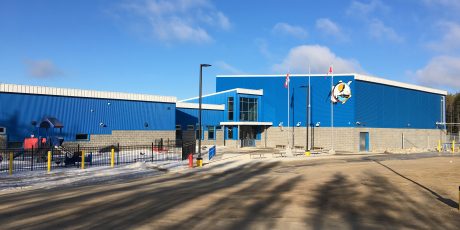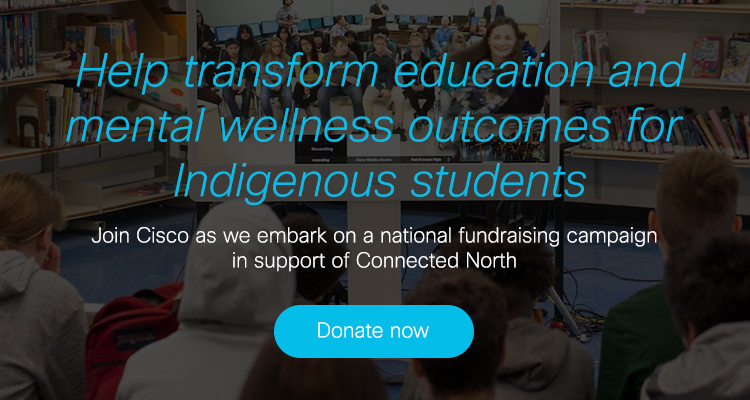
Stories of Connected North – Tony Allen: Bringing Canadians Together
Tony Allen has been a Systems Engineer with Cisco Canada for 18 years, after retiring from the Canadian military. He has been involved with the Connected North program since its inception and installed the first video conferencing unit, in Iqaluit.
Here is his story of Connected North, in his own words.
 In early 2013 I was asked if I was interested in participating in Connected North. Jeff [Seifert, former Cisco Canada CTO] and I had worked with each other a lot over the years and he knew of my military background providing telecommunications for sites in the high arctic. He knew I had experience up north, knew the lay of the land. I jumped at the chance. First, it was an opportunity to go back to the north. If you spend a lot of time up there, it becomes a magnet. It is like nowhere else.
In early 2013 I was asked if I was interested in participating in Connected North. Jeff [Seifert, former Cisco Canada CTO] and I had worked with each other a lot over the years and he knew of my military background providing telecommunications for sites in the high arctic. He knew I had experience up north, knew the lay of the land. I jumped at the chance. First, it was an opportunity to go back to the north. If you spend a lot of time up there, it becomes a magnet. It is like nowhere else.
I also knew just how tough it is to communicate when you are up there. Back in the day, it was a phone call home once every 5 days for 10 minutes on a radio patch. Knowing that we could bring video conferencing and technology to the north was compelling. To be honest, I didn’t really have a grasp as to how it would look and feel for kids in grade 6, 7, 8. Once I got to experience that, to see their reaction, it was like “wow”. It took it to a whole other level.
That’s why I got involved.
When we went for the first install, I showed up with a great, big flyway bag with all kinds of stuff. Ratchets, wrenches, tie wraps, soldering iron. Jeff looked at me like I was crazy. I said “I’ve been to the north, I know. One missing screw or screwdriver and it’ll put the kibosh on a whole project.”
On the people side, you have to remember that you’re a stranger from the south. You’re trying to be as low key as possible. You’re trying to bring technology to the children, the elders, and the teachers, all with different perspectives. But you are an outsider and you have to be respectful, respectful because they have their own ways of being and you don’t want to intrude. You have to be aware that you are there to provide something, but not to overwhelm, direct, or to be the boss. You try to fit in.
My favourite Connected North memory is not one lasting impression or one experience: it’s the reaction of the students. It plays out the same over and over. Every classroom we went in, when we finally made the first call south with the children in the room, they start really shy. Then they see someone, open up and are going crazy, the way children do. Whether it was Iqaluit, North Spirit, Poplar Hill; even the schools down here in [Toronto]. I installed a unit in Bishop Strachan School [a private school in Toronto] and even the 16-, 17-year old young ladies thought it was really cool.

Students in Cadotte Lake, Alberta
It feels very good to be able to bring technology in and shrink the distance, the size of the country for children. I’m a big advocate of education, especially STEM (Science, Technology, Engineering, Math) and girls in STEM. My daughter is in second year of computer science and math at McMaster. It makes me feel great that we can bring technology to children and hopefully make education more relevant. Because books didn’t do it for me, I wasn’t a book learner, I was more hands-on. And this type of technology is modern day, hands-on.
It’s enabling in so many ways. Enabling education for children, enabling cross-cultural connections, enabling north south connections. Enabling experiences for elders, educators, and children that they just didn’t have. A phone call is not a video conference.
That’s why I hope, technology-wise, we’re going to start using the full Cisco Spark suite. To start to change the way educators are capturing content, working with both the children, the parents, the other folks that help to provide curriculum, education, and content. Pushing beyond traditional video conferencing and scheduled remote experts to a more living, always-available resource.
The Spark Board is a more relevant experience for the children: you can touch it, you can doodle with it, you can interact with it both from within the room – but also across the network. It can share and capture content, whether it be recordings of the sessions or the interactions taking place on the Spark Board itself. It becomes the repository that allows you to return to the content.
This program, I think it is going to take on a life of its own. More momentum, much bigger than anything I thought about. A real opportunity to expand everywhere in the north, across the near north and all remote locations. Even cooler would be if we can take it to regional southern schools, so we really start to bring everything together. Because the true value of this program is trying to make the country smaller.
We are all Canadian. We’re trying to bring everyone together across so many different layers, most importantly the children. They’re the future of the country.
That’s where it can go. That’s where I’d like it to go.




